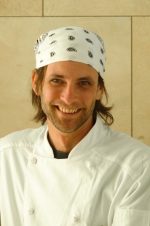Interview with Chef James Richardson of Nook - Los Angeles, CA
Antoinette Bruno: Why did you start cooking? What or who inspired you to become a chef?
James Richardson: I was cooking to put myself through school. The chef I was working for was injured, and I was asked to fill-in for him. I was 21 years old and that accident changed my life. It was just fate. Although I was always interested in the culinary arts, this opportunity changed my focus, and I really began to take cooking seriously.
AB: Did you attend culinary school? Would you recommend culinary school to aspiring chefs today?
JR: I never went to school. It can be a good thing, a good jump for kids. I do feel that school is good for learning the basics, but I usually dissuade kids from going to school before working in the kitchen. It is important for people to understand the reality and pressure of actually working in a kitchen.
AB: Who are your mentors? What are some of the most important things you’ve learned from them?
JR: Jeanie Pierola. She is an incredible chef. I worked in a few restaurants with her. She is corporate chef at Sideburn’s and Bern’s Steakhouse. From her I learned passion: being excited about what you are doing. I also learned about wine from her and a deep appreciation for pairing food with wine. She was generous with her knowledge.
AB: What is your philosophy on food and dining?
JR: There is a theory in philosophy that there are no original ideas, all ideas are already out there. The same can be said about food. You have to make the basic ingredients, like ideas, your own. I have learned over time to focus on a few key elements, simple bold flavors, keeping a dish true to its integral ingredients.
AB: Are there any secret ingredients that you especially like?
JR: Braised meats of any kind – cooked to perfection, and unusual heirloom legumes.
AB: What is your most indispensable kitchen tool?
JR: My microplane – it’s the best thing since the rubber spatula. It’s fast and easy, and I can use it for so many things.
AB: Is there a culinary technique that you have either created or use in an unusual way?
JR: I like to use slow cooking methods, but I haven’t yet used sous vide. I also use spice rubs a lot. I make a curry spice and my own curing blends, like the coriander cure.
AB: What is your favorite question to ask during an interview for a potential new line cook?
JR: What was your favorite dish at your previous restaurant and please describe to me how it’s made. I’m looking for passion. You can teach technique, but you can’t teach someone to care.
AB: What tips would you offer young chefs just getting started?
JR: You should be learning something every day from anyone in your kitchen—including your dishwashers. I’ve learned some great things from those you least expect.
AB: What are your favorite cookbooks?
JR: I don’t really have any favorites, but I do love Julia Child and Jacques Pepin books. They’re incredible, old school, but ground-breaking nonetheless. They really were turning points for the industry in their time. Also, Sheila Lukins’ first cookbook was really the first modern gourmet cookbook. All the recipes work and they are well explained.
AB: What cities do you like for culinary travel?
JR: San Francisco, New York, and Paris. There are so many great chefs in one city. I love New Orleans, one whiff of the humid air and I know I am home.
AB: What are your favorite restaurants –off the beaten path – in your city?
JR: There are no unbeaten paths in Los Angeles, but I do enjoy the fried lentils at Cobras and Matadors. And for Mexican: Allegria in Silverlake for their carnitas.
AB: What trends do you see emerging in the restaurant industry now?
JR: I see more mid-priced, chef-driven, neighborhood restaurants.
AB: Where do you see yourself in 5 to 10 years?
JR: Hopefully I’ll have two more restaurants. I’d like small neighborhood restaurants but with different concepts.






